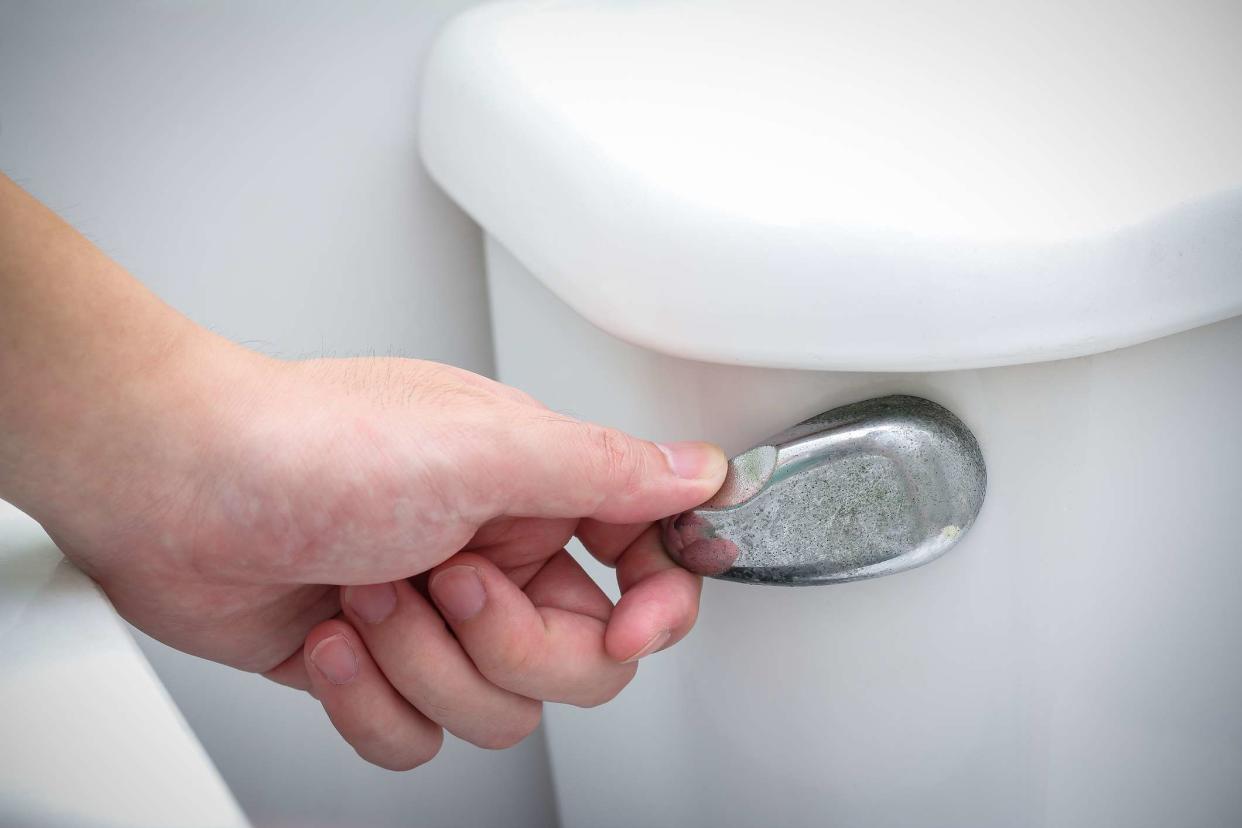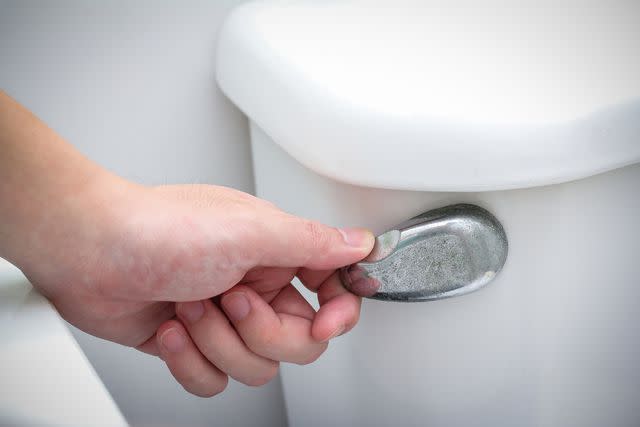Steatorrhea (Fatty Stool)

shayneppl / Getty Images
Medically reviewed by Shadi Hamdeh, MD
Steatorrhea means there is too much fat in the stool (poop). It can be caused by eating too many high-fat foods or by fat malabsorption associated with conditions such as exocrine pancreatic insufficiency (EPI), bile salt deficiency, and celiac disease. Fat malabsorption means your body isn’t properly digesting food or absorbing nutrients.
This article discusses the symptoms and potential causes of steatorrhea. It also covers risk factors and when to seek testing and treatment for your symptoms.

shayneppl / Getty Images
Symptoms of Steatorrhea
With steatorrhea, stools contain a lot of fat, so you might notice they have a greasy film coating. You might also see drops of grease or oil in the toilet water or on toilet paper after you wipe.
If you have steatorrhea, your stools may be:
Foul-smelling
Bulkier than normal
Other symptoms of fat malabsorption may include:
Abdominal pain or cramping
Indigestion or heartburn
Is Steatorrhea Serious?
Occasional, mild-to-moderate cases of steatorrhea may be unpleasant but usually are not anything to be concerned about.
Steatorrhea itself is not serious, but it can be a sign of an underlying condition that is serious. This is particularly true if you experience fatty stools regularly or with symptoms such as dehydration, weight loss, or muscle weakness.
For example, steatorrhea can be associated with malnutrition or weak bones (osteoporosis).
When essential nutrients are not properly digested and absorbed, they do not reach the cells and organs that need them to function properly. As a result, fat and nutrients remain in the stool and are excreted. If this occurs over a long period, unintentional weight loss and nutritional deficiencies can occur.
Causes of Steatorrhea
Steatorrhea can occur if your digestive system can’t effectively break down the fats in your food. Your body may also be unable to properly absorb some of the nutrients from your food, including fat, vitamins, and minerals.
In other cases, people might be deficient in compounds necessary for healthy digestion. Here are some common causes of steatorrhea.
Exocrine Pancreatic Insufficiency
Exocrine pancreatic insufficiency (EPI) occurs when the pancreas does not make enough digestive enzymes (proteins that help speed up chemical reactions) for normal fat breakdown or digestion. The result is fat remaining in your stool instead of being digested and absorbed into your body.
EPI can be caused by conditions that affect the pancreas, such as:
Pancreatic cancer
Bile Salt Deficiency
Bile salt deficiency is another common reason for steatorrhea. Diseases in your liver and bile ducts decrease the liver's ability to make bile salts and the bile ducts' ability to deliver it. Bile salts are needed to help break down fats, aid in digestion, absorb vitamins, and eliminate toxins.
Conditions that may cause insufficient bile in the body include:
Liver failure
Biliary atresia (blockage of the tubes that carry bile from the liver to the gallbladder)
Other bowel diseases
Malabsorption
Another cause of steatorrhea can be malabsorption due to intestinal conditions that affect the intestinal tract's ability to absorb fat and nutrients.
Intestinal conditions that may cause malabsorption include:
Surgical resection of the bowel
Whipple disease (a rare bacterial infection)
Other malabsorption syndromes
Medication Side Effects
Some medications can cause changes to your stool, including steatorrhea. Alli or Xenical (orlistat) is one such example.
Orlistat is a lipase inhibitor, which means it prevents some of the fat in foods consumed from being absorbed in the digestive tract. This means it stays in the stool.
Diet
Although it's unusual, eating very high-fat and/or very high-fiber meals might cause short-term steatorrhea.
Common foods high in fat and/or fiber that may lead to steatorrhea include:
Deep-fried foods
Cookies, cakes
Chips
Fatty fish, such as salmon
Coconut or palm oils
Whole nuts
Whole grains
Natural fats (e.g., jojoba oil and fish oil)
Artificial fats (e.g., olestra)
Excessive alcohol can also lead to fatty stools.
Other Causes
Some other potential causes of steatorrhea include:
Lactose intolerance
Infections of the digestive tract
Damage or injury to the intestines
How to Treat Steatorrhea
Treatment for steatorrhea depends on the cause. Work with a healthcare provider to correctly diagnose the cause of fatty stools and accompanying symptoms.
Lifestyle Changes
Mild or acute cases of steatorrhea may be treated at home. This includes:
Resting
Staying hydrated
Diet
If your steatorrhea is associated with a medical condition that is treated with diet, additional changes to what you eat and drink can help. For example, avoid foods and beverages with lactose if you are lactose intolerant.
If you have celiac disease, avoiding all foods and beverages containing gluten is essential to help decrease symptoms.
If steatorrhea is short-term and caused by foods you recently ate, try the following tips:
Avoid very high-fat meals and snacks. Limit red meat, processed meats, butter, cheese, cream, coconut and palm oils, sweets, and desserts.
Avoid very high-fiber foods. Although fiber provides many health benefits, limiting high-fiber foods and supplements temporarily may reduce steatorrhea symptoms. It's recommended that once symptoms improve it is important to add high-fiber foods back into your diet as tolerated.
Limit or avoid alcohol. Excessive alcohol intake may worsen symptoms of steatorrhea.
Medications
Sometimes a combination of dietary changes, medication, and nutritional supplements are needed to treat conditions that cause steatorrhea.
For example, people with EPI need to ensure they eat a healthy, nutrient-rich diet, take pancreatic enzymes with each meal and snack, and take vitamins and supplements to ensure they get all the nutrients they need.
Other medications may include:
Over-the-counter antidiarrheal medications
Over-the-counter medications for indigestion
Consult your healthcare provider if you have chronic or severe steatorrhea associated with other malabsorption symptoms.
Diagnosing Steatorrhea and Its Cause
To diagnose steatorrhea, a healthcare professional will usually ask about your symptoms, review your medical history, and might order tests to check the fat content of your stool.
Qualitative test. This stool test measures under a microscope the number of fat globules (drops) in one stool sample.
Quantitative test. This stool test is collected over 72 hours while consuming a diet containing a certain amount of fat (usually 100 grams daily). Excreting 7 grams of fat or less over 24 hours is considered normal. If the fat content of the stool is higher, it suggests that the body is not absorbing fat and steatorrhea may be diagnosed.
D-xylose test. D-xylose is a kind of sugar. This test measures the absorption of D-xylose by measuring levels of D-xylose in your blood or urine.
Additional Testing
If your doctor diagnoses steatorrhea, you will likely need additional testing to identify the underlying cause.
For example, a biopsy of the small intestine may be done. This is a procedure that removes cells or tissue to be tested and examined under a microscope.
In some cases, imaging of organs like the pancreas may also be ordered.
When to See a Healthcare Provider
Severe or chronic steatorrhea requires attention from a healthcare provider.
Also contact your provider if you experience symptoms associated with related complications, including:
Stunted growth in children
Chronic fatigue or exhaustion
Easy bruising or bruising that takes a long time to heal
Summary
Steatorrhea, or fatty stool, may be caused by diet or be a sign of malabsorption, such as seen in cystic fibrosis or some pancreatic diseases. Signs of steatorrhea include foul-smelling, greasy, mucousy, or bulkier-than-normal stools.
Most mild or acute cases can safely be treated at home. However, severe or chronic cases require medical attention to determine the underlying cause of the steatorrhea. The cause dictates proper treatment.

